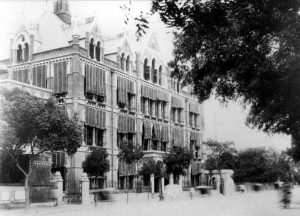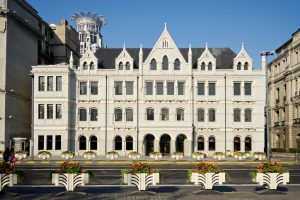Buildings located on the Bund in Shanghai, China are pillars of the city’s global history. Elements including the concept of each buildings, construction materials, and outside versus inside building appearances reflect ideas of historical significance and change/continuity through time. The Russell & Company Building in Shanghai, China captures, and sequesters, Shanghai’s history in its outward facing exterior. Like many elements of the built city landscape, the Russell and Company building has persisted through time, yet components of this structure have been molded by the evolution of the Chinese state; this evolution and subtle changes alongside posit the Russell and Company building an important component of Shanghai’s global history. (specify the notion of “global history” as the bund as the treaty port speaks for a special identity and history)

Historical photo of the Russell and Company Building, late 19th Century – 1881. Eric Politzer, 2007
The Russell and Company Building’s original exterior reflecting modernization attempts from Chinese stakeholders, while still incorporating neo-classical European elements. Built in the late 19th-century under architectural designers Morrison & Gratton, the building reflected neo-gothic and neo-classical elements, in addition to red brick design and colorful window awnings. Pictured above, we get a vague sense that the building was unlike other buildings along the Bund at the time. The red brick colors and window awning elements separated the Russell and Company building from different monolithic buildings, such as the HSBC building and the Customs House; both these buildings are washed out by their granite exteriors and harken back to ideas of neutral monument and building palettes provided by buildings and monuments in Tiananmen Square. At the time of construction, the Russell and Company building reflected attempts at modernizing China, but once the ownership of the building transferred from American stakeholders to Chinese stakeholders, the building’s outward expression changed, too. (if the intention of modernization in terms of the architecture is the focal point in this section, then use all the visual elements to support whether the attempt of modernization is achieved or failed and why)

A “modernized” Russell and Company Building, now the China Merchants Bank. Tour-Beijing. com
Chinese ownership of the Russell and Company Building changed the structure from colorfully unique to neutral and ordinary (what does the transition speak for: need a topic sentence that introduces a topical idea). The building was purchased by the China Merchants Bank in the early 20th-century. At this time, the building was re-worked and renovated to better adjust the building for its new purpose of banking (define what is the “new purpose”). Above, we see that the building adopted a neutral, gray color scheme, devoid of color and devoid of unique building character. Though the exterior is not dominated by granite blocks, there is now a monumentality of the exterior, which allows it to blend into the larger Bund landscape. The transition from red-brick color to painted grays may be reflecting shifts in the Chinese state’s view of their built landscape (if this is the focal point, then introduce it at the beginning of the paragraph) or shifts in the use of the building. It would be erroneous to assume that the burgeoning communist state alone was the driver in “neutralizing” the Russell and Company Building’s appearance (or rendering the colonial impact); it very well may be the case that the shift into a Chinese bank induced desires for building owners to want the building to blend in with other banking buildings on the Bund.
Aspects of changing ownership and state influences are omnipresent in consideration of our built landscape. The Russell and Company building demonstrates both ideas beautifully. For a building which was once lauded as unique and exemplary, with regards to modernization, the reality of it now being lost in the larger strip of the Bund has allowed us to understand that the Bund consumes all potential for buildings to stand out. We understand that each building was constructed with competition for riverfront access in mind; this doesn’t necessarily allow for uniqueness of the structure to come through. Instead, it would make sense for individual building elements to allow for each building to shine, but if we consider all buildings together, there ceases to be uniqueness; the only uniqueness is the Bund itself, for its history of a littoral landscape makes it contrasts against other built landscapes, particularly the Pudong, another critical aspect of the Shanghai city identity. The Russell and Company Building is now consumed by the Bund’s littoral identity, yet in doing so, there story of the building’s consumption is telling of how the Bund has shaped up to be the iconic, yet monochromatic, historical landscape we see it as. (if littoral identity or space is the key issue, then may make it as the overarching central thesis)
Citations:
Politzer, Eric , “Number 6 on the Bund: Looking back. New facts about an old building” (2007)
http://www.tour-beijing.com/blog/category/shanghai-travel/shanghai-attractions/page/7
